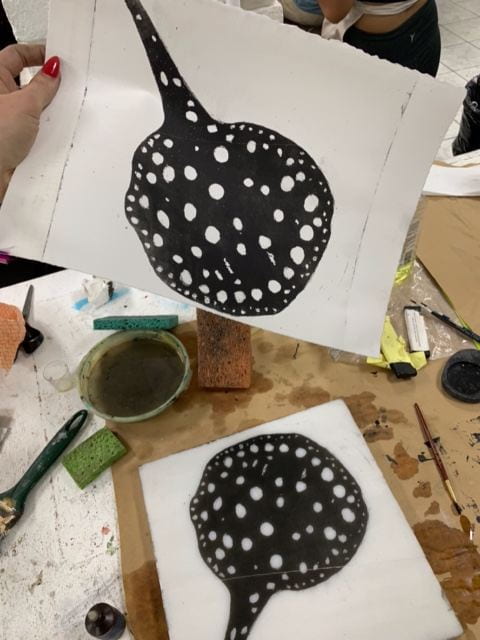SJSU Lecturer Irene Carvajal teaches printmaking to her students. Lithography is one of the processes she teaches, a medium that has changed very little in the last 300 years.
“For hundreds of years we’ve used the same materials,” Carvajal said. “The joke in the art department is that if Rembrandt were to rise from the dead, everything would shock him except the printmaking department.”
For the last two summers, Carvajal and some of her students traveled to Costa Rica for a summer faculty-led program (FLP) to explore ways to move printmaking into the modern world by moving from petroleum-based, toxic and limited materials, to sustainable materials.
The seed of summer program began several years before when Carvajal visited her home country and visited her alma mater University of Costa Rica. She described the country as having a strong environmental identity and a place where artists and citizens celebrate the natural riches of the country. At the university, she paired up with artists and scientists to explore sustainable materials that might be used in printmaking.
“The only reason we use petroleum is because of its PH and chemical properties,” she said. “But that naturally occurs in fruit and plants, such as lemon juice, pineapple juice and honey. We cook with these things on a daily basis and realized the properties actually match the properties of petroleum. We can etch on stone or metal with these materials.”

Lecturer Irene Carvajal and students visited the rain forest in Costa Rica for inspiration for their art.
Working with the College of Professional and Global Education and with Susie Morris, the director of Study Abroad and Away, Carvajal developed curriculum and an itinerary for a three-week summer program. In 2018, 11 students participated and this summer eight students traveled with her. The SJSU students spent half-days during the week at the University of Costa Rica.
“The world of art is not particularly sustainable most of the time,” said SJSU photography student Nanzi Muro. “At the University of Costa Rica, I learned that it is possible to be a viable artist when creating art. It is a process that takes time and many steps, but it is a matter of wanting to make the change of being a sustainable artist. I have already started the process, and now it is time to continue practicing the steps I learned in my lithography class in Costa Rica.”
The students spent the rest of the day with curators, gallerists, visiting museums as well as government agencies, and nonprofits focused on the environment. Weekends included hikes through national parks or organic farms.
“We traveled to top of the rainforest and swam in hot springs, but we were always looking for some inspiration to take back to class,” said another student, Rene Campos. “Whether it was leaf patterns or volcanic rocks we were always trying to find something from our new surroundings to adapt to our lithographs. “
For part of the visit, the students traveled to a remote rain forest region to experience an innovative rural tourism experiment. Three decades ago, 25 families submitted claims to the Costa Rican government for farmland.
“When they arrived, they realized that it was beautiful,” she said. “There was a waterfall and a river, and all sorts of animals and plants. They decided to farm a small portion and keep the rest as a tropical rain forest.”
The Costa Rican group applied for a grant to get money to build eight small, minimal houses on the property. The houses are rented out to scientists, environmentalists or others who want to study the region or learn about the culture in the rural area.
“We were the first group of artists to visit,” Carvajal said. “They taught us about plants, animals and their way of life. We ate from what grew around us, we became part of their family, we taught them how to screen print and make ink out of the native plants.”
Upon returning to SJSU, the students put together an exhibition of the work they created while in Costa Rica. She describes art as the record of what is going on that can be a record of what is going on in the world when it is created.
“As a multicultural person who has lived back and forth in multiple countries, one thing I have thought is that in developed nations we tend to fix problems with money,” she said. “In countries such as Costa Rica there is no money so people have to be creative to come up with solutions to fix their problems. I teach my students the creative process is not just artistic – it is an everyday activity that has to do with looking at life and how to make it better.”


